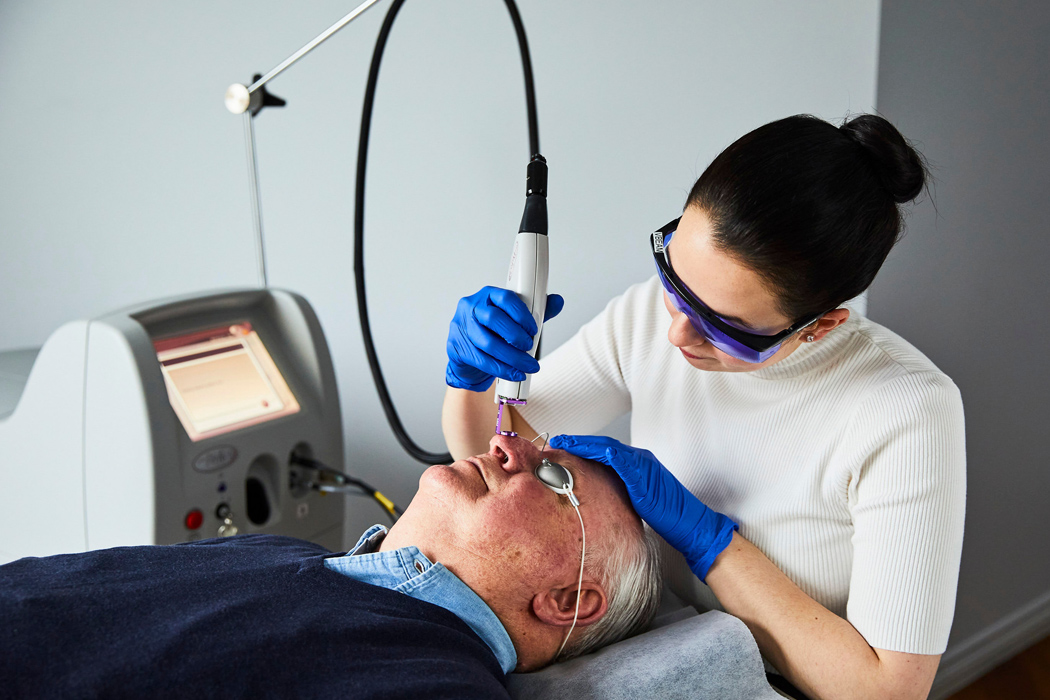How are rosacea and couperose different?
Publié le
Many people confuse rosacea and couperose, which are common diseases. Although couperose is actually a type of rosacea, it is important to distinguish between the two, as treatments for rosacea and couperose are often different. It is also important to understand the causes of these diseases, which are too often blamed on alcoholism. Let’s take the time to understand the differences between rosacea and couperose.

What is rosacea?
Rosacea is a chronic inflammatory disease that is fairly common among people with fair skin and can cause embarrassment. It affects the small vessels of the face, resulting in redness, primarily in the centre of the face. It is often accompanied by flushing, a hot or even burning sensation on the face. Rosacea can also lead to deformation of the skin’s contours, which is called phymatous rosacea. The most common example is thickening of the nose with an irregular contour.
Rosacea is often erroneously associated with alcoholism. Although alcohol does exacerbate rosacea, it is not the cause. Rosacea is a hereditary condition that will affect the majority of fair-skinned people of Northern European origin to some degree over the course of their lives. What is sometimes referred to in popular jargon as “brandy nose” or “gin blossoms” are indeed cases of untreated rosacea, but alcohol is not necessarily the cause, although it may have contributed to aggravating it.
Several other factors can exacerbate rosacea. Among the most frequent are sun exposure, the transition from the warmth of our homes to the cold of our Quebec winters, hot beverages and spicy foods. However, it is possible to reduce the effect of these factors, for example, by protecting yourself with sunscreen or by covering your face in cold weather.
Rosacea can also take other forms, from simple redness to papules (red pimples) or pustules (whiteheads). This is known as papulopustular rosacea or acne rosacea.
Approximately twice as many women as men suffer from rosacea, which rarely develops before age 30.
Rosacea at a glance
:
-
Common inflammatory disease that affects especially women over 30 years old
-
Causes facial redness and hot or burning sensations
-
Can also take the form of red pimples or pustules
-
May cause deformations of the skin’s contours, particularly on the nose
-
Main causes: genetics, sun exposure, transitioning from warmth to cold, hot beverages and spicy foods
What is couperose?
This is the vascular, and most widespread, form of rosacea. It presents with dilated vessels (telangiectasias). Although rosacea can take other forms such as papules (red pimples) or pustules (whiteheads), the most telltale sign of couperose is permanent redness in the centre of the face (cheeks, nose, centre of the forehead, chin), while the eyes and mouth remain unaffected.
Couperose at a glance:
-
The vascular, and most widespread, form of rosacea
-
Redness usually affects the cheeks, the nose, the centre of the forehead, the chin, but not the eyes or the mouth
Rosacea Treatments
Although rosacea is a chronic disease with no cure, there are several treatments available to help control it and return to normal.
Several forms of rosacea can be effectively treated with various prescription creams or oral treatments.
Couperose Treatments
Couperose and diffuse redness, however, do not respond as well to prescription creams or oral treatments. Fortunately, some aesthetic treatments such as pulsed dye laser (vascular laser), intense pulsed light as well as laser Genesis produce excellent results. They do not cure rosacea, but they can reduce it by making many of the surface vessels disappear.
It takes an average of three treatments, one month apart, to obtain a good response. The treatments must be subsequently maintained, depending on the disease activity. For some patients, treatments may be required every six months, every year, or even every three or five years.
Do you have symptoms of rosacea and/or couperose? Make an appointment with Clinique D for a consultation and advice from our specialists.
Share this:
VIEW ALL POSTS